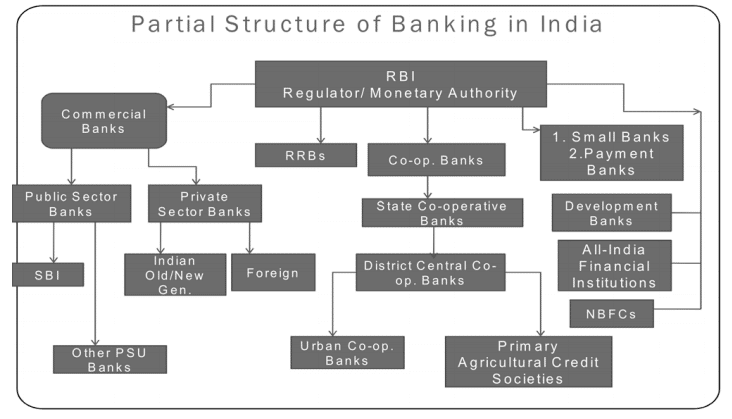Indian Banking System: India has one of the largest and a Biggest Banking system in the world which forms the backbone of its economy, where the old and the new banks coexist in new service of the nation, having evolved over a period of more than two centuries.
Banks is the back bone of a country financial system. Modern Banking system in India is more than two centuries old. The Indian banking system consists of various constituent banks which mobilize savings from several sources for lending to productive activities. These banks are regulated by Reserve Bank of India (RBI) which came in to existence in 1935.
RBI controls credit, issues currencies and regulates banks and other nonbanking financial companies. Keeping in mind all these the chapter covers evolution of banking system in India, role of RBI and structure of banks which are a must for any student of Banking. The topic and contents are of Level 1 orientation and will expose students about evolution of banking in India, RBI and about structures of banks in India
Quick Links
Indian Banking System – An Evolution
The Evolution of Indian Banking System encompasses Agency House Banks, Presidency Banks, Imperial Bank of India, Reserve Bank of India, Private/Joint Stock Banks (Old generation private sector banks), State Bank of India, Associate Banks, Nationalized Banks, Old and New Generation Private Sector Banks, Foreign Banks, Co-operative Banks, Regional Rural Banks, Small Banks and Payment Banks and Financial Institutions known as Development Banks and Non-Banking Financial Companies.

BRIEF OVER VIEW OF THE START OF RESERVE BANK OF INDIA (RBI)
In1927, the British government appointed a commission under Hilton-Young (known as the Royal Commission on Indian Currency and Finance) with the main objective to separate the control of currency and credit from the government, as well as spread the banking network across the country. The commission recommended setting up a central bank in India known as Reserve Bank.
However, initially the proposal was not accepted. Later, with a few modifications it was reintroduced and finally it was accepted in 1934. As a consequence, Reserve Bank of India (‘RBI’) was established on 1935 as a banker to the central government. It was initially head quartered in Kolkata and commenced its operations from April1, 1935. Later in the year 1937 it was shifted to Mumbai.
At the beginning of its operation, RBI was started as a privately owned entity with a share capital of Rs. 5 crores; almost fully subscribed by private shareholders excepting a token shareholding (2.2 per cent) of the Central Government. In 1948, the Central Government took over the institution through an Act named Reserve Bank (Transfer to Public Ownership) Act. All private shareholders were paid compensation. The complete government take over took place in 1949 as RBI started in statutory role from January 1, 1949.
Private /Joint Stock Banks
There were many commercial banks that were started as Private/Joint stock banks in India. The Allahabad Bank in 1865 was one of the earliest joint stock banks started in India. Subsequently it was nationalized in 1969 and continues its existence. On 30 August 2019, the Ministry of Finance announced that Allahabad Bank would be merged with Indian Bank, another nationalized Bank. The proposed merger would create the seventh largest public sector bank in the country with assets of Rs.8 lakh crore..
Oudh commercial Bank was the first joint stock bank conducting its operations from 1881 to till it failed in 1958. In 1894 The Punjab National Bank was established at Lahore, is now one of the largest public sector banks in India.
The period between 1906 and 1920 saw the establishment of banks inspired by the ‘Swadeshi’ movement. Inspired by the movement, native Indians founded banks to serve the Indian community at large.
A number of banks established as joint-stock banks then, have survived to the present day such as Bank of Baroda, Central Bank of India, Catholic Syrian Bank, The South Indian Bank, Bank of India, Corporation Bank, Indian Bank, Indian Overseas Bank. The Swadeshi movement also had its impact in South Kanara district of present day Karnataka State in which Syndicate Bank, Corporation Bank, Canara Bank, Vijaya Bank and Vysya Bank were founded.
Consequent upon nationalization of banks in 1969 and 1980, as well as economic liberalization ushered in 1991-92, there was a profound impact of expansion of bank/branch network of banks in India.
Agency House Banks/Presidency Banks/Imperial Bank of India
Though money lending and trade credits were known in India since Vedic period and subsequent times, seeds of modern Banking system was sown in India in the year 1776, when Bank of Hindustan at Kolkata (the then capital of British in India) was established by the British agency house of Alexander and Company for catering to the needs of British merchants operating in India.
This bank can easily said to be the first commercial bank in India. This was followed by General Bank of India in 1786. However liquidation proceedings were started in the year 1829 for winding up Bank of Hindustan and finally it was liquidated in 1832. The General Bank of India survived only for five years and in the year 1791 it failed.
Thereafter, Bengal Presidency (equal to present day State Government) established a Bank called Bank of Calcutta in the year 1806 which was later rechristened as Bank of Bengal in 1809. The Bank was funded by the Presidency of Bengal. This was later followed by two more Presidency Banks namely Bank of Bombay in the year 1840 and Bank of Madras in 1843. All three Presidency banks were incorporated as joint stock companies.
Under Royal charter “these three banks received the exclusive right to issue paper currency till 1861 when, with the Paper Currency Act, the right was taken over by the Government of India”. Later these three Presidency banks were merged to form Imperial Bank of India in 1921, which in 1955 was renamed as State Bank of India. Until the birth of Reserve Bank of India in 1935, the Presidency Banks and later Imperial Bank of India were acting as a sort of bankers to the government, by holding Government of India’s balances”, a function which was later taken over by RBI upon its commencement.
During the period, British merchants established the Union Bank of Calcutta in 1829, first as a private joint stock association, then converting in to a partnership. Union Bank was incorporated in 1845 but failed in 1848, as it became insolvent. Bank of Upper India, which was established in 1863 and survived until 1913.
Recommended






